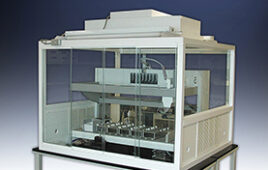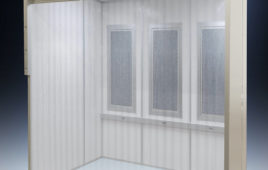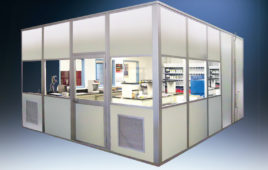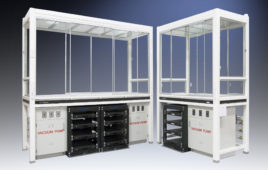“LET’S ANALYZE IT BY GC/MS”
The suggestion is often heard in troubleshooting or, proactively, in validating critical cleaning processes. The term GC/MS is familiar to most analytical scientists and engineers and also, due to popular TV crime shows, to much of the general public. GC/MS consists of two analytical techniques used in tandem: gas chromatography (GC) followed by mass spectrometry (MS).
CHROMATOGRAPHY
In chromatography, molecular species in a mobile phase are separated by elution through a column containing a stationary phase. GC terminology dates to early chromatographic analysis that involved a transparent tube or column packed with a solid sorbent, the stationary phase. Classically, the unknown material is placed at the top or inlet to the column. A liquid, the mobile phase, is passed through the column, carrying the unknown with it.
The time it takes for a molecule to move through the column is a function of the interaction with the mobile and stationary phases. Components of the unknown mixture are eluted (washed) from the column at different times. In early chromatography, colored bands (thus the root “chroma”) would be distinguishable in the column, each band associated with a specific molecule.
In a GC, the mobile phase is a gas such as He, H, Ar, or N. Most GCs now use an internally coated, narrow bore capillary tube, frequently coiled, instead of a packed column as the stationary phase. Separation of molecules occurs via different adsorption (stickiness) characteristics between the carried molecule and the stationary phase, so some molecules are washed, or elute, from the column sooner than others.
MASS SPECTROMETRY
After the initial chromatographic separation, mass spectrometry further separates molecules by charge-tomass ratio. Ionized molecules are spatially deflected, either by magnetic or electric fields, as they pass through. The higher the charge-to-mass ratio, the greater the deflection.
MORE OPINIONS ARE BETTER
The combination is more powerful than either separate technique because in GC/MS, molecules are separated both temporally (GC) and spatially (MS) see figure. As in many analytic techniques, looking at an unknown in different ways—obtaining more than one opinion— yields more evidence and makes the determination less ambiguous. In addition, as manufacturing becomes more complex, the sample to be analyzed may contain many different chemicals. Different molecules may have similar elution times through a GC or similar charge-to-mass ratios in an MS but the combination strongly reduces the chances of erroneous identification. In cases where further discrimination is needed, for example in a forensics investigation, it is possible to input the output of GC/MS into still more analytical instruments, including an additional MS stage (GC/MS/MS).

(Click Image For A Larger Version)
APPROPRIATE ANALYSIS
GC/MS can be very specific and very sensitive. It is also costly, and it is not always the correct approach. No analytical technique is an ultimate crystal ball. It is, at the end of the day, a form of chemical profiling based, in part, on what we suspect might be in the sample. Considerable technical skill and experience are required to select the appropriate analytical conditions including sample preparation and handling, and analytical variables. Not all chemicals are good candidates for GC/MS. The chemical must be volatilized. If the injection temperature is well below the boiling point of the chemical, it is highly unlikely that detection will occur. Volatilizing involves heat; heat can enhance reactivity and/or dissociation. When this happens, rather than distinct, separated compounds, the analyst may observe a smear-o-gram—an uninterpretable mess.
Even when the technique is successful, what do you do with the information? Detecting a contaminant chemical does not automatically mean that there is too much. There is a tendency among both regulatory agencies and manufacturers to have a “zero tolerance” policy and to tie lower detection limits to rejection, without considering whether or not this action is technically or economically justified.
Barbara Kanegsberg and Ed Kanegsberg, Ph.D. “The Cleaning Lady” and “The Rocket Scientist,” are independent consultants in surface quality including critical/precision cleaning, contamination control, and validation. They are editors of “The Handbook for Critical Cleaning,” CRC Press; an updated two-volume second edition. Contact BFK Solutions LLC, 310-459-3614; [email protected].




